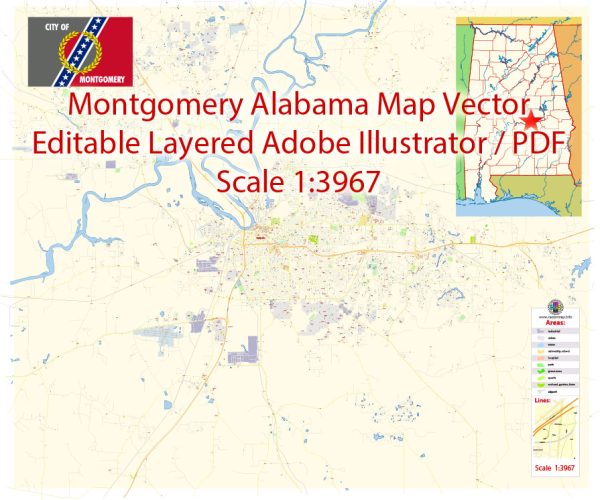Montgomery, Alabama, has a rich history of urban development that reflects the broader historical and social changes in the United States. The city, situated along the Alabama River, has played a significant role in American history, particularly during the Civil Rights Movement. Here is a brief overview of Montgomery’s urban development:
- Early Settlement and Antebellum Period (Pre-1861): Montgomery was founded in 1819 on the site of a former Native American settlement. It quickly became the state capital of Alabama in 1846. During the antebellum period, the city thrived as a center for the cotton trade, and its economy was heavily dependent on slavery.
- Civil War and Reconstruction (1861-1877): Like many Southern cities, Montgomery experienced the hardships of the Civil War. The city served as the first capital of the Confederate States of America in 1861. After the war, during the Reconstruction era, Montgomery faced economic challenges and worked to rebuild its infrastructure.
- Post-Reconstruction Era to the Early 20th Century: In the late 19th and early 20th centuries, Montgomery underwent significant economic and industrial growth. The city’s economy diversified, and the railroad played a crucial role in connecting Montgomery to other parts of the region. The cotton industry continued to be important, but other industries, such as manufacturing and trade, began to flourish.
- Civil Rights Movement (1950s-1960s): Montgomery gained international prominence during the Civil Rights Movement. In 1955, Rosa Parks, an African American woman, refused to give up her seat to a white man on a city bus, leading to the Montgomery Bus Boycott—a pivotal event in the struggle for civil rights. The city became a focal point for civil rights activism, with leaders like Martin Luther King Jr. playing a central role.
- Urban Renewal and Modernization (Mid-20th Century): Like many American cities, Montgomery experienced urban renewal efforts in the mid-20th century. This involved the demolition of older structures and the construction of new buildings and infrastructure. These changes aimed to modernize the city but sometimes resulted in the displacement of established communities.
- Contemporary Developments: In recent decades, Montgomery has continued to grow and develop. Efforts have been made to preserve and celebrate the city’s historical sites, including those related to the Civil Rights Movement. The downtown area has seen revitalization, with an emphasis on historic preservation, tourism, and cultural events.
Overall, Montgomery’s urban development reflects the broader historical currents of the American South, including the challenges of slavery, the impact of the Civil War, economic transformation, and the struggle for civil rights. Today, the city stands as a testament to its complex history, with a blend of historic charm and modern development.


 Author: Kirill Shrayber, Ph.D.
Author: Kirill Shrayber, Ph.D.